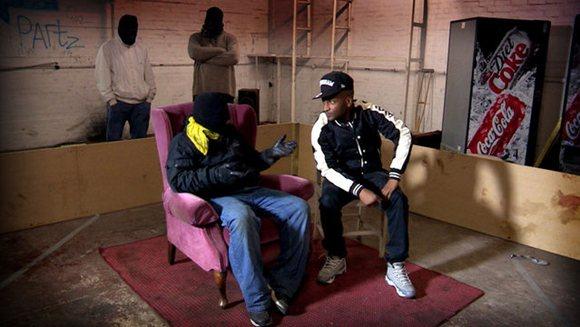Two years ago Penny Woolcock was at the heart of Birmingham street gangs in her documentary One Mile Way; that one was titled after the fact that two of the city’s competing outfits were separated only by the distance of the film’s title. In Going to the Dogs, she's back in the same 'hood, this time investigating the city’s dog-fighting scene, with the help of one of the earlier film’s lead protagonists, Dylan Duffus, who proved here a very able narrator-presenter.
Tracking down, and ensuring the cooperation of the participants for Dogs… looked like it proved more challenging. No surprise when dog-fighting has been on the statute books as a criminal offence since 1835 (despite the statistic reported here, that it’s up by 400% in recent years). So Dylan (the unmasked one, main picture) was in search of “a man, who knows a man, who knows a man”, about a dog.
The one main OTC (off-the-chain) fight that was recorded wasn’t that lurid
Which made disguise a crucial element in the presentation of those whom they managed to find who were ready to talk to camera, first among them the appropriately named “El Primo”. He was disguised not only in a balaclava, but with creepily slow voice distortion that made him seem he was from another, extra-terrestrial world.
All too terrestrial this experience was though, even if our perspectives on its surroundings were largely shot at night – how else do you give a pit bull his daily exercise, six miles a turn, and even have him pulling his master (on a bicycle) up hills for stamina-building, except under the cover of darkness? Actually, there was an alternative: 20-minute turns on a canine treadmill (yes, really).
Channel 4 kept a certain degree of vigilance to keep Going to the Dogs from advance critical eyes, but the result wasn’t as remorseless as might have been expected. The one main OTC (off-the-chain) fight that was recorded wasn’t that lurid: the usual, expected audience (gamblers obviously, too) of around 40 reached barely a dozen, deterred by the presence of cameras. A second fight never happened, given that one main prize-fighter dog (“the Russian”) had been apprehended by police and put down before that stand-off could take place. (A detail that certainly challenged our perception of what was actually “humane” in this equation.)
Any owner who went in for alternative methods, like electric shocks or drowning, was a 'cruel bastard'
Instead, we had owners detailing the closeness of their relationships with their dogs – how the canines “repped” their masters, in rather the same way that gang allegiances are predicated on loyalty. And pit bulls are more loyal than humans. Actually, El Primo reckoned that in decades of dog-fighting experience, from perhaps 600-700 fights he’d only seen about three that ended in fatality. The film went in for Brechtian-style inter-titles, and in the one titled “The Killing” we heard instructions on the only way to “fix a mash-up dog”, ie. put it out of its misery – a hefty injection of anaesthetic. Any owner who went in for alternative methods, like electric shocks or drowning, was a “cruel bastard”. Which also left you thinking about Duffus’s and his pals’ approach to what they admitted they thought was morally wrong. If you’re watching it live, it’s horrible, but watch it on Youtube (we saw clips from Kashmir, where dog-fighting is legal), and it doesn’t hit you the same way. Apparently.
You wondered whether it was the lack of actual fight sequences that prompted Woolcock to broaden her subject towards wider concepts of mankind using animals for sport, image, or assertion of authority. Cue rather abstract cross-comparisons, from the likes of “Legal Scholar” and “Historian”, on the relative merits of rearing animals for meat, or using them for sport (the number of race-horses shot after injuries on the turf probably exceeds the annual number of dogs killed in fights).
Which brought it all back to one of Woolcock’s more telling themes, class. It was hard to find much humour in Going to the Dogs, but when we came up against the juxtaposition of the crew – Duffus and his fellow Birmingham sound-recordist – and some hoorays (“The Sportsmen”) out shooting posh birds, it was certainly there. Relative values again: from the braying shooter we got the distinction between shells (for war) and cartridges (“for partridges”, ho-ho). But the best line came from the Birmingham side, “First time I’m standing by a live shot-gun, and there’s no crime in it.” Woolcock got close to her mark here, but finally, somehow, didn't hit it.















Add comment